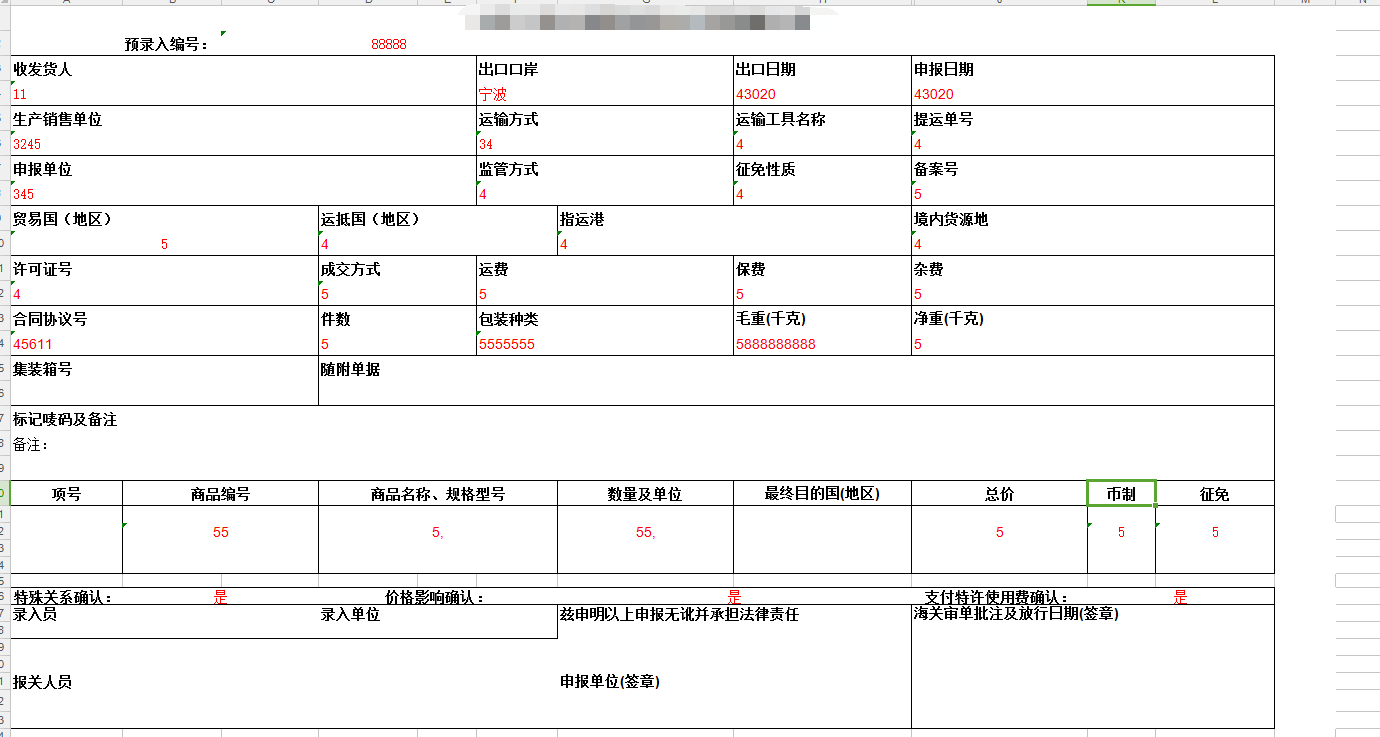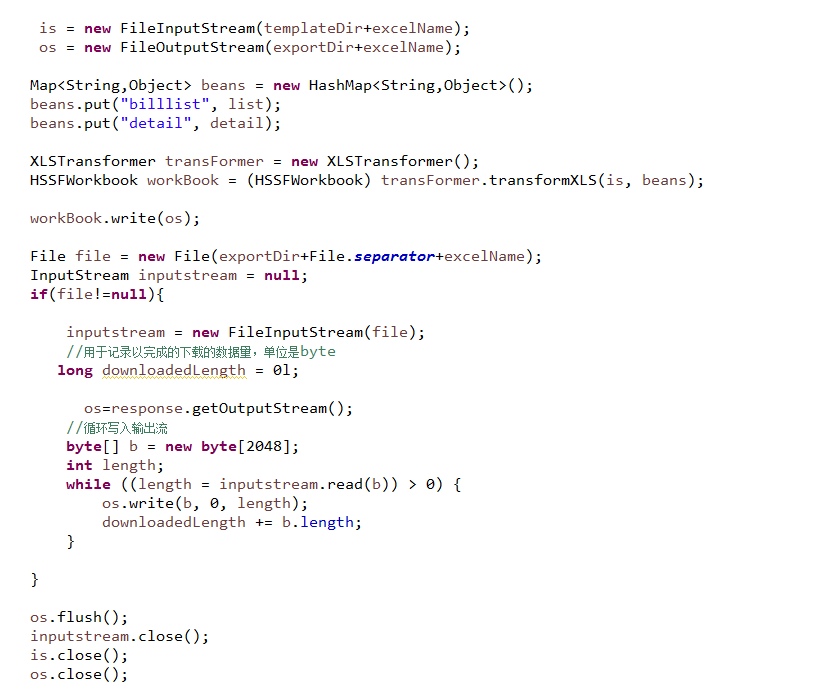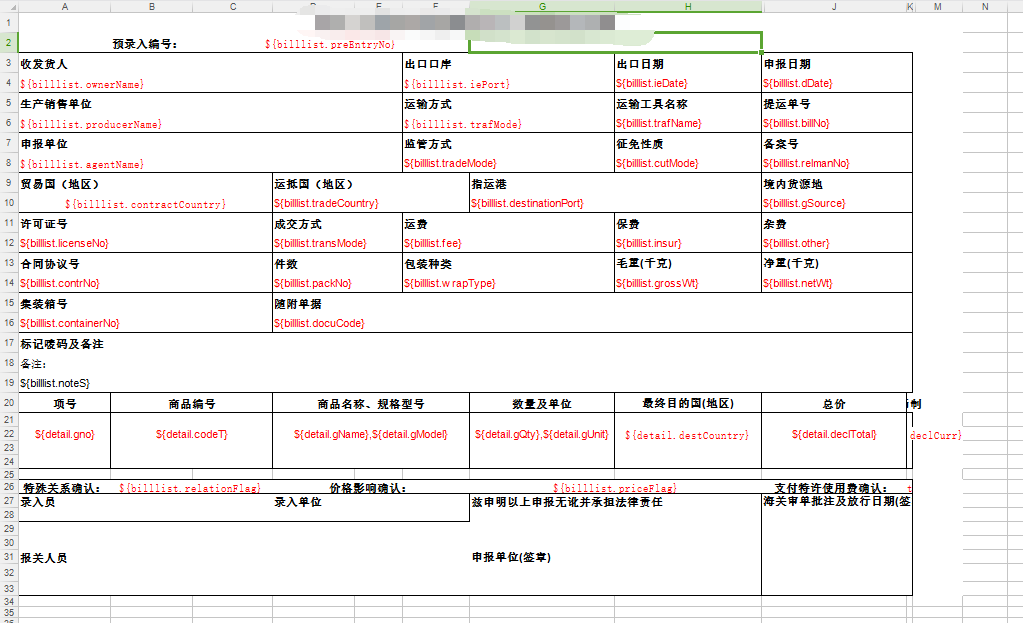最近项目开发当中要求实现导出功能,查看了很多人的博客但是感觉对于复杂的导出还是感觉好麻烦,代码量太大,为此,想了多种方法,最后找到了最简洁的一种方法,如下:
1.要实现的导出功能模板如下:
2.按常规解决方法做如下导出显然是不明智的,为此,Java中提供了一个jar包可以实现这种复杂的导出
3.导入jxls包

4.在Controller中代码如下:
(1)首先实现数据查询

(2)获取项目中放入Excel模板的路径以及导出Excel的路径

(3)将项目路径放入读取流,导出路径以及文件名放入输出流,然后用Map实现key-value的方式写入Excel,此处的list和Detail是查询出来的结果集,然后就是用我们导入的jar包功能啦,使用XLSTransformer,将结果集写入Excel,然后在获取导出的文件路径,在客户端实现下载导出的功能

4.Excel模板如下,此处必须用${key.value}输出值的方式,否则无效

5.附上源代码:
@RequestMapping(value = "/export.do",produces="text/html;charset=utf-8") @ResponseBody public void export(HttpServletRequest req,HttpServletResponse response) throws Exception { Long id = (long) Integer.parseInt(req.getParameter("id")); List<CustomsDeclareBill> list = customsDeclareBillService.selectByPrimaryKey(id); List<CustomsDeclareBillDetail> detail = customsDeclareBillDetailService.getSelectDetailById(list.get(0).getId()); if(list!=null && !list.isEmpty()||detail!=null&&!detail.isEmpty()){ InputStream is = null; OutputStream os = null; try { //文件名 String excelName = "中华人民共和国海关进口货物报关单.xls"; excelName = java.net.URLDecoder.decode(excelName,"utf-8"); //获取Excel模板的路径 /** * 获取项目路径 * 1.this.getClass().getClassLoader().getResource("/").getPath(); * getClass().getProtectionDomain().getCodeSource().getLocation().getPath(); * 2.req.getSession().getServletContext().getRealPath("/resources/upload"); * 3.servletContext.getRealPath("/").substring(0, servletContext.getRealPath("/").lastIndexOf("seawin-webapp-base")) * */ //String templateDir = "C:/Users/Administrator/Desktop/"+java.net.URLDecoder.decode(excelName,"utf-8"); String templateDir =servletContext.getRealPath("/").substring(0, servletContext.getRealPath("/").lastIndexOf("seawin-webapp-base"))+"/seawin-pcweb/"+"/exceltemplates/" ; //导出Excel路径 String exportDir=servletContext.getRealPath("/").substring(0, servletContext.getRealPath("/").lastIndexOf("seawin-webapp-base"))+"/seawin-uploadfile/"; //设置响应 response.setCharacterEncoding("utf-8"); response.setHeader("Content-Disposition", "attachment;filename=" + new String(excelName.getBytes(), "ISO-8859-1")); response.setContentType("application/vnd.ms-excel;charset=utf-8"); is = new FileInputStream(templateDir+excelName); os = new FileOutputStream(exportDir+excelName); Map<String,Object> beans = new HashMap<String,Object>(); beans.put("billlist", list); beans.put("detail", detail); XLSTransformer transFormer = new XLSTransformer(); HSSFWorkbook workBook = (HSSFWorkbook) transFormer.transformXLS(is, beans); workBook.write(os); File file = new File(exportDir+File.separator+excelName); InputStream inputstream = null; if(file!=null){ inputstream = new FileInputStream(file); //用于记录以完成的下载的数据量,单位是byte long downloadedLength = 0l; os=response.getOutputStream(); //循环写入输出流 byte[] b = new byte[2048]; int length; while ((length = inputstream.read(b)) > 0) { os.write(b, 0, length); downloadedLength += b.length; } } os.flush(); inputstream.close(); is.close(); os.close(); } catch (InvalidFormatException e) { e.printStackTrace(); }catch (Exception e) { e.printStackTrace(); } } }
好了,这样就可以实现导出功能了,再复杂的Excel导出使用此种方式都能够化繁为简,喜欢的小伙伴就将此文顶上去让更多人看到吧!
链接:想研究XLSformer的小伙伴可以给你们一个链接:http://blog.csdn.net/hu_shengyang/article/details/6736789,该链接写的很详细哦,并且可以实现往Excel中插入动态图片等等。